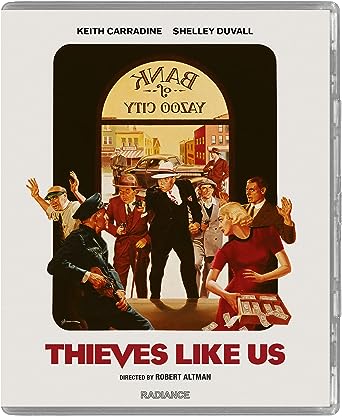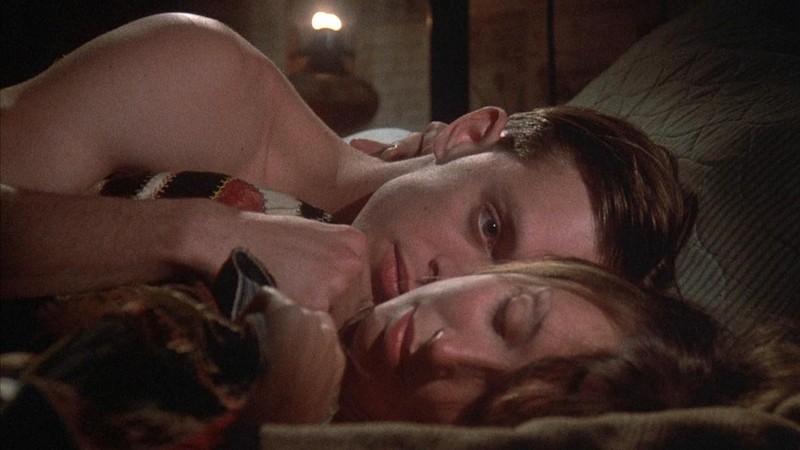Thieves Like Us, Robert Altman’s 1974 evocation of 1930s Mississippi, wasn’t a commercial hit on its original release, even though Pauline Kael called it a masterpiece.
This Depression-era tale of a trio of hapless bank-robbers was shot on location with no star names. Keith Carradine plays Bowie, the youngest of the thieves who have just escaped from a chain gang. In jail since he was 16, he has a naiveté that Carradine captures beautifully.
Holed up in a small town, the loose-limbed Bowie falls for a local girl, Keechie, played by Shelley Duvall in her first major role. Struck by her unique look and gauche charm when he met her, Altman had convinced her to take a small part in Brewster McCloud (1970), and she and Carradine had both appeared in minor roles in Altman's McCabe and Mrs Miller (1971). Casting relative unknowns in the lead meant that Altman struggled to raise a big budget for Thieves Like Us
 Playing older bank robbers, John Schuck and Bert Ramsen, members of Altman's repertory company, support the young actors well. But it’s Louise Fletcher’s performance as a local matriarch exercising quietly coercive control on family and robbers that stands out. Spotted by Miloš Forman in Thieves Like Us, Fletcher went on to play Nurse Ratched in One Flew over the Cuckoo’s Nest (1975), winning a BAFTA, a Golden Globe, and an Oscar.
Playing older bank robbers, John Schuck and Bert Ramsen, members of Altman's repertory company, support the young actors well. But it’s Louise Fletcher’s performance as a local matriarch exercising quietly coercive control on family and robbers that stands out. Spotted by Miloš Forman in Thieves Like Us, Fletcher went on to play Nurse Ratched in One Flew over the Cuckoo’s Nest (1975), winning a BAFTA, a Golden Globe, and an Oscar.
Comparisons with Bonnie and Clyde didn’t do Thieves Like Us any favours. This is a warmer, gentler film than the former and wears its period credentials lightly rather than fetishising authenticity.
Without the budget that had enabled him to build McCabe's frontier town from scratch, Altman wanted to get as far away from studio interference as possible. For locations, he cherry-picked Mississippi towns barely changed since the ‘30s, the kind that Tom Waits once described as "just a wide spot in the road". They only needed to be enhanced with a little set dressing and a handful of vintage cars.
On the commentary track, Altman describes how he chose to work with the French New Wave cinematographer Jean Boffety because he didn’t want a cameraman with preconceived notions of what Depression-era America looked like. The atmospheric camerawork features a moody palette of muted colours. Scenes were shot through rain-spotted windscreens; characters were framed in doorways with reflections off glass.
Altman asked Joan Tewkesbury, whom he had first employed as a script girl on McCabe, to adapt the 1937 novel by Edward Anderson. In a revealing new interview with Tewkesbury, shot by Radiance Films for this Blu-ray edition, the writer-director, now 87, claims that neither she nor Altman had seen They Live by Night, the 1948 film noir Nicholas Ray made from the same pulp novel.
Ray goes for a driven, more melodramatic style, very different from Altman’s relaxed approach. When days of rain stopped exterior filming, Altman and Tewkesbury came up with a scene where the bank robbers play act their next robbery in a living room with the help of the local children. There's a humour and lightness in Altman's story-telling that Ray's film lacks, but Ray makes up for with pacing. It would be intriguing to see the two films on a double bill.
One feature running throughout Thieves Like Us is the use of extracts from radio broadcasts on the soundtrack. News reports of the robbers' escapades were created for the movie, but we also hear moments from The Shadow, Orson Welles’s radio drama, and an adaptation of Romeo and Juliet that counterpoints Keechie and Bowie's love story. Reminiscing about his childhood in '30s Kansas, Altman recalls how everyone listened to the radio and this edition includes two dramas found in the archives.
Radiance has done Thieves Like Us proud with this edition. As well as the new Tewkesbury interview, there's a fresh interview with Carradine. He gives a lovely, energetic account of working on the film. His memory of making it is excellent and he provides fascinating observations on his own acting process and Altman's methods. As well as the insightful commentary the director recorded for an MGM edition in 2007, there’s a booklet with well-written essays on the film by Pamela Hutchinson and Alan Schroeder.














Add comment